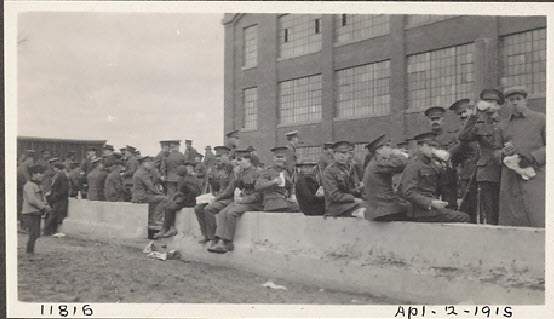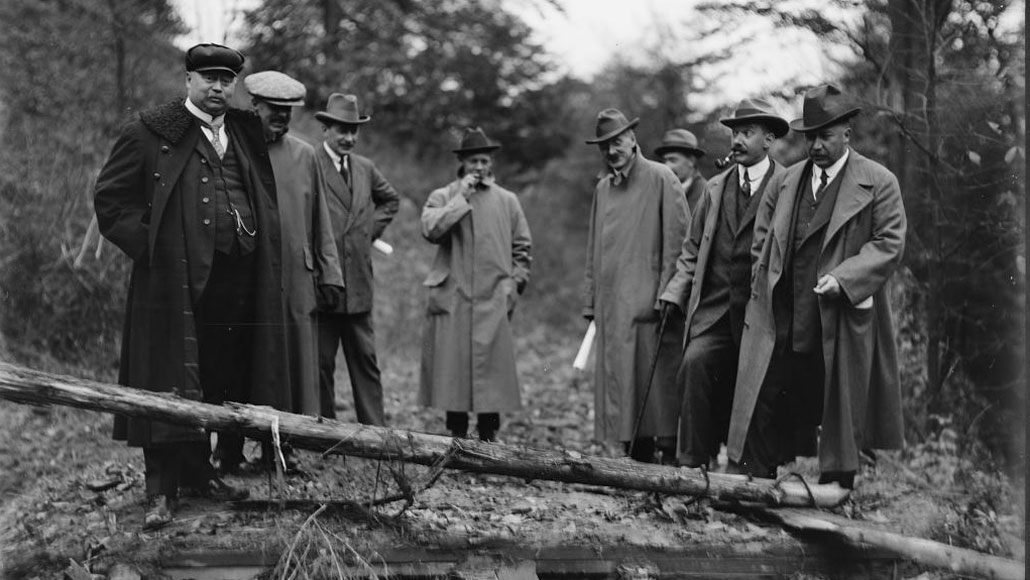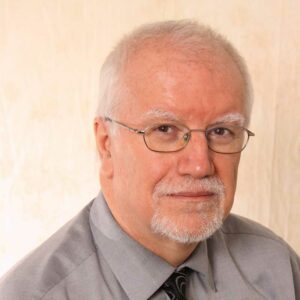
Soldiers having lunch at Canada Wire and Cable factory, Leaside sham battle, April 2, 1915. Photo Toronto City Archives.
Leaside’s association with military activities is well known. During World War I, the town was home to the Leaside Munitions Company and the Leaside Aerodrome, where combat pilots trained before heading overseas. World War II saw the rise of the huge industrial complex, Research Enterprises Limited, which manufactured radar and optical equipment for the war effort.
Less familiar, however, is the role Leaside played – especially before and during World War I – as a setting for military exercises. This was a role for which it was well suited given its diverse topography, sparse population (at the time) and rural character. Normally taking place at Thanksgiving, these annual “sham battles” or “sham fights” were staged across Toronto and Ontario. This included Leaside, where from 1913 to 1915, at least seven sham battles were fought or planned.

Leaside’s cancelled sham battle of 1913
Scheduled for October 20, the 1913 Leaside military manoeuvres involved 1,500 troops drawn from such regiments as the Queen’s Own Rifles, the Grenadiers and the 48th Highlanders. The troops were divided into two detachments – “White” and “Brown.”
As reported in both the Toronto Star and Globe, the plan was to have the Brown force pursue the Whites westward from Donlands along Eglinton Ave. While under pursuit, the Whites were expected to halt at Leaside and attack – checking the Brown’s advance.
Complicating matters was the fact that two bridges along the Don River near Eglinton needed to be repaired for the exercise to go forward. The organizers asked residents to furnish material for the project but were refused. This forced army engineers to repair the bridges themselves. They did so under the watchful eye of Sir Henry Pellatt, owner of Casa Loma, who also was Commander of the Queen’s Own Rifles and Director of Operations for the manoeuvres.
Everyone expected a splendid show – including the young Leaside diarist Wendell Lawson, who mentioned it in his journal. But when the big day arrived, it rained so hard the event had to be cancelled – to the disappointment of many.
Four sham battles in 1914
The following year, in May, Leaside was the scene of another exercise.
This one did go ahead and involved several regiments, including the Governor General’s Bodyguards, the Mississauga Horse and the 48th Highlanders. These troops attacked a smaller force north of the Leaside train station but were severely beaten when they rashly advanced over open ground, making themselves easy targets for the defenders.
Five months later, a second “battle” transpired, also in the open fields north of the Leaside station. About 200 soldiers of the 10th Royal Grenadiers practised skirmishing and outpost duties and engaged in a small mock fight in the afternoon, where each soldier was issued 20 rounds of blank ammunition.
Two more sham conflicts took place in November. This time, the participants were U of T students, many of them members of the university’s Overseas Training Company. According to the student newspaper, The Varsity, the second of these conflicts saw 500 forestry and dentistry students march from University College to McRae Drive and on to “the plain west of Leaside” – where the two groups squared off in a pretend fight that ended up stalemated in the Don Valley.
1915: the year of big manoeuvres
In 1915 Leaside was again the scene of two mock battles.
The first was on April 1-2 involving more than 4,000 men. On the first day, 3,500 soldiers marched 20 miles to Leaside where they fought a mock battle resulting in a draw. The next day another 700 men, from the 109th Regiment, marched to Leaside from Pearl Street. On arrival, they had lunch at the Canada Wire & Cable/Leaside Munitions factory before commencing “hostilities” and dividing into two groups – Red and Blue. The “Reds” were tasked with guarding supplies at the Canada Wire Factory. The “Blues” were to attack them and capture the supplies and the factory – which they did successfully.
But by far the largest exercise took place on November 26. Described by The Toronto Star as “one of the biggest tactical operations ever attempted,” it involved over 6,000 overseas troops – divided into White and Blue groups. Reginald Pellatt, son of Sir Henry, commanded the White army; Lt. Col. R. C. Windeyer commanded the Blue. The groups “fought” in an open field along Eglinton Ave. eastward to the Don Valley. The Blues attacked the Whites, who were protecting supplies. Each battalion received 4,000 rounds of blank ammunition. The exercise lasted all afternoon, but it was unclear who won in the end. It was “the largest sham battle ever fought around Toronto”– and it all happened in Leaside.


